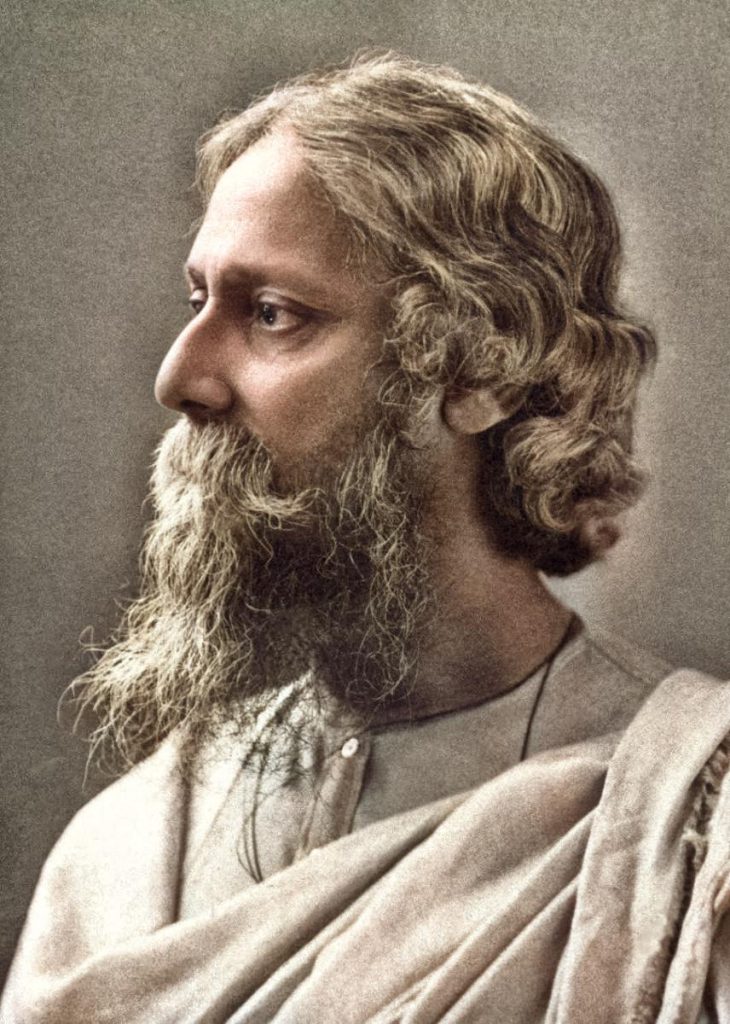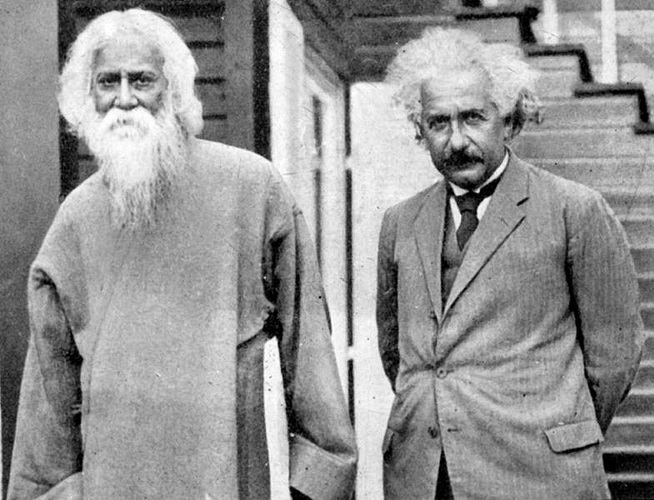
Rabindranath Tagore (1861-1941)
On May 7, 1861, Bengali polymath and Nobel Laureate Rabindranath Tagore was born. He was highly influential in introducing the best of Indian culture to the West and vice versa, and he is generally considered as the outstanding creative artist of modern India.
“The truth comes as conqueror only because we have lost the art of receiving it as guest.”
– Rabindranath Tagore, The Fourfold Way of India (1924);
The Youngest of Thirteen Children
Many of you might never have heart of the great Indian poet, who also was the first non-European to receive the Nobel Prize in Literature back in 1913. But, besides his ‘elegant prose and magical poetry’, he also composed music and created paintings. Actually, there are two nations that even have chosen his compositions as national anthems. Rabindranath Tagore was born on May 7, 1861 as youngest of thirteen surviving children in Calcutta, India to a Brahmin family that was able to date their ancestors back to the 15th century. “Rabi”, as Rabindranath was called, was raised mostly by servants. His mother had died in his early childhood and his father Debendranath Tagore, a leader of the Brahmo Samaj, which was a new religious sect in nineteenth-century Bengal and which attempted a revival of the ultimate monistic basis of Hinduism as laid down in the Upanishads, travelled widely. His home hosted the publication of literary magazines; theatre and recitals of both Bengali and Western classical music featured there regularly. Actually, Tagore largely avoided classroom schooling and was tutored by his brother Hemendranath and later also by his father in drawing, anatomy, geography and history, literature, mathematics, Sanskrit, and English – his least favorite subject.
“God, the Great Giver, can open the whole universe to our gaze in the narrow space of a single land.”
– Rabindranath Tagore, Jivan-smitri
Studying Law
Because Debendranath wanted his son to become a barrister, Tagore enrolled at a public school in Brighton at age 17. But, after a few months he left school without finishing his degree and opted instead for independent study of Shakespeare. In 1880 he returned to Bengal degree-less, resolving to reconcile European novelty with Brahmo traditions, taking the best from each. In addition to his many-sided literary activities, he began to manage the family estates, a project which brought him into close touch with common humanity and increased his interest in social reforms.
He wrote one of his most famous poems during these years:
“Nirjharer Swapnabhanga” (The Fountain Awakened from its Dream):
I shall rush from peak to peak,
I shall sweep from mount to mount,
With peals of laughter and songs of murmur
I shall clap to tune and rhythm.
His Most Productive Period
In the years 1891–1895, Tagore’s so-called Sadhana period, was his most productive. He wrote more than half the stories of the three-volume, 84-story Galpaguchchha with its ironic and grave tales examining the poverty of an idealised rural Bengal. In 1901 Tagore also founded an ashram, i.e. an experimental school at Shantiniketan where he tried his Upanishadic ideals of education. Although Tagore wrote successfully in all literary genres, he was first of all a poet. With his translations of some of his poems he became rapidly known in the West. He had great interest in village reconstruction, India culture, music and dance. He was himself a good singer and he composed a new form of music called “Rabindra Sangeet”. In November 1913, Tagore learned he had won that year’s Nobel Prize in Literature: the Swedish Academy appreciated the idealistic – and for Westerners . accessible nature of a small body of his translated material focussed on the 1912 Gitanjali (Song Offerings). In his homeland Rabindranath was enthusiastically celebrated after the announcement despite all former criticism – but the new fame soon burdened the poet.
“When old words die out on the tongue, new melodies break forth from the heart; and where the old tracks are lost, new country is revealed with its wonders.”
– – Rabindranath Tagore, Gitanjali (1912)

Rabindranath with Einstein in 1930
Later Years
Tagore also participated in the Indian nationalist movement, though in his own non-sentimental and visionary way; and Gandhi, the political father of modern India, was his devoted friend. Tagore was knighted by the ruling British Government in 1915, but within a few years he resigned the honour as a protest against British policies in India. Rabindranath Tagore was highly influential in introducing Indian culture to the West and is generally regarded as the outstanding creative artist of modern India. From 1914 to 1921 more than 20 books with Rabindranath’s works were published in English; translations into other European languages were not from Bengali but from English.
At the age of 67, Rabindranath discovered drawing and painting for himself – expressionist works were created, some of which met with incomprehension in his environment. After a failed operation in July 1941, Rabindranath died on August 7, 1941.
Uma Das Gupta, Rabindranath Tagore: Citizen of His Country and the Universe, [6]
References and Further Reading:
- [1] Rabindranath Tagore at Nobelprize.org
- [2] Biography of Rabindranath Tagore at online-literature.org
- [3] Works of Rabindranath Tagore at wikisource
- [4] Rudyard Kipling and his Tales of India, SciHi Blog
- [5] Rabindranath Tagore at Wikidata
- [6] Uma Das Gupta, Rabindranath Tagore: Citizen of His Country and the Universe, antiniketan to Smithsonian: A Tribute to Tagore, Smithsonian Education @ youtube
- [7] Lubet, Alex. “Tagore, not Dylan: The first lyricist to win the Nobel Prize for literature was actually Indian”. Quartz India.
- [8] Tagore, Rabindranath (2003), Rabindranath Tagore: Lover of God, Lannan Literary Selections, translated by Stewart, T. K.; Twichell, C., Copper Canyon Press
- [9] Jha, N. (1994), “Rabindranath Tagore”, PROSPECTS: The Quarterly Review of Education, Paris: UNESCO: International Bureau of Education, 24 (3/4): 603–19
- [10] Sen, A. (1997), “Tagore and His India”, The New York Review of Books
- [11] Works by or about Rabindranath Tagore at Internet Archive
- [12] Timeline for Rabindranath Tagore, via Wikidata





